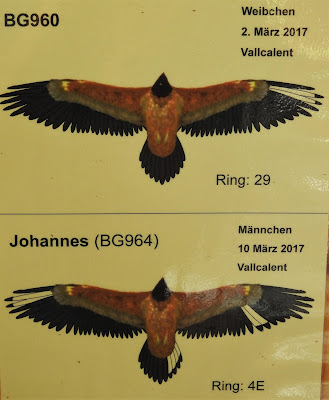A few summer days on home turf with Mike. We started our tour in Valais, above the pines of the Pfyn-Finges Nature Park.
At the Devil's Bridge by Rotafen, a few km east of Leuk, we searched for Wallcreepers - but to no avail. Instead, we were treated to a pair of young Sparrowhawks (Accipiter nisus) performing acrobatic antics over the trees below us.
From Leuk, a drive up to Leukabad spa town - in time to luxuriate in an outdoor hot pool.
Next morning, a cable car up to the 2,270m Gemmipass to scan around the Daubensee.
We watched an Ibex (Capra ibex) cross the steam feeding the lake.
Alpine Choughs (Pyrrhocorax graculus) flew around the restaurant, looking for scraps.
On the path Swiss Brassy Ringlets (Erebia tyndarus) sunbathed.
In the foliage close by, low-flying Scotch Burnets (Zygaena exulans).
Then eastwards, along the valley to Fiesch and the cable car up to Eggishorn - at nearly 3,000 m, a panoramic view over the Aletsch Glacier.
At these alpine heights, plants have evolved to survive by reducing their foliage and clinging to cracks in the rocks. But in the short days of summer they bloom with a flower meadow magnificence. I am growing Saxifrages in my rock garden. Here we saw two species in the wild, Saxafraga bryoides...
...and Saxafraga exarata.
Also in flower, one of the Mouse-eared Chickweeds, the One-flowered Mouse-ear (Cerastium uniflorum).
And for the daisies, Leucanthemopsis alpina...and Arnica montana.
Further north, the mountain tourist resort of Melchsee-Frutt - to search for Lammergeier (Gypaetus barbatus). On the boating lake, a homage to the great beast gives us hope.
We walked up the valley which leads to the pass between Rotsandnollen and Graustock.
The rocks around us have been squashed and folded over millions of years, in nature's attempt to make filo pastry.
The whistles of the Marmot (Marmota marmota) can be mistaken for a bird of prey.And at the end of the valley, a small observation hut aimed at the Rotsandnollen. For it is in the shade of this peak that the Lammergeier can be found.
This predictability is due to the fact it has been introduced here from other parts of Europe, and provided with food. For monitoring, distinctive markings have been painted on their wings.This is Johannes, only a few months old.
There is a rumour that a kettle of Griffon Vultures (Gyps fulvus) is visiting the peaks above Boltigen in the Simmental - a potential rare sight of a southern species. We head off, and find a suitable observation point.
Out of the clouds we saw a few descend and pass by the rock face.
































No comments:
Post a Comment